|
There are some major spoilers towards the end of this
review,
so proceed with caution if you don't know the film
"I'll take you straight to hell, fucker!" |
Frank Booth |
I
remember clearly my first viewing of David Lynch's Blue
Velvet. It was at the Lumiere Cinema in St. Martin's
Lane in London. It had only been showing for a week or so, and
a close friend and I made a special trip to the capital
in order to see the latest work from the man who had given
us the mind-bending Eraserhead, the deeply
moving The Elephant Man, and the wonderfully
non-formulaic and visually splendiferous Dune.
Advance word on this one was intruguing, to say the least – a detailed article in Time Out suggested that this
was a darkly troubling work whose attitude to women was
likely to cause some upset, but that it was nonetheless too
powerful, too imaginative to dismiss. The Lumiere screening played to a full
house and both my friend and I both emerged from the experience with mixed emotions. In a nearby pub
afterwards, we tried to work out whether we had watched
a bold experiment with moments of greatness, or a visionary work of
considerable brilliance. The spectacular artificiality of
the ending in particular had left me a little bewildered.I pondered on what I had seen for several weeks, unable to
shift it from my mind. Then I saw it again and the confusion
was gone. Everything now seemed to make perfect sense, and I now
knew exactly what I had seen: a genuine, dyed-in-the-wool
modern masterpiece. Twenty years and a great many viewings later,
I've not changed that view and if anything have become more
convinced of its validity. Lynch has made great movies since, had us all eating
cherry pie and drinking damned fine coffee with Twin
Peaks, but this remains probably his most perfectly realised work, and one that is touched throughout
with genius.

A
little bit of plot for newcomers. On his way back from visiting
his father in hospital, young Jeffrey Beaumont finds a human
ear in a field near his house. He takes it to Detective Williams,
an old family friend at the local police department. He asks Jeffrey not to pursue the matter further, but Jeffrey's love of mysteries
prompts him to secretly launch his own investigation anyway. He is aided by
the detective's daughter Sandy, who has overhead enough
details of the case to point Jeffrey in the direction of beautiful nightclub
singer Dorothy Valens. After stealing a spare set of keys
while posing as a pest controller, Jeffrey lets himself
into Dorothy's apartment one evening when she is at work in order to search of possible clues. When she returns unexpectedly he is forced to hide in the wardrobe, where he witnesses something the opens his eyes to a dark world he was previously unaware of, and propels both his investigation and his
personal life in unexpected and dangerous directions.
Lynch
lays out his plan of action from the opening shots. To the
serene beat of Bobby Vinton's title song, impossibly picturesque
shots of white picket fences, gloriously coloured flowers
and cheerful, waving firemen give way to a Sunday afternoon
vision of a middle-aged man watering his lawn. This is Lumbertown,
a serene corner of suburban America, where the sun always shines
and everyday life is peaceful and respectable, where families
all love each other and children respect their
elders. Then something unexpected happens – the hose becomes
caught on a plant, and as the man tries to free it
he suffers a stroke and falls writhing
to the ground. As his dog energetically plays with the water
still spraying from the hose that its master still has hold of, the music mutates into a sinister tonal rumbling
and the camera snakes its way through the grass and into
the ground beneath, coming to rest in huge close-up on an
army of crawling bugs, the noise of their burrowing exaggerated
to such a degree that it blocks out all other sound. This short sequence is the entire film in microcosm, as Lynch drags us beneath the surface of an idyllic vision of small town life to confront its unseen dark and sinister underside.
Although
the narrative proper takes its time to make a similar underworld descent, Lynch drops plenty of pointers
on the way, drifting fascinatingly between the picture postcard world of Lumbertown life and the troubling hints of dark things to
come. When Jeffrey goes to visit his father in hospital,
for example, he finds him not waiting expectantly in bed
or even attached to the standard breathing mask and drip, but encased in a ghastly
collection of primitive-looking clamps and tubes, like some
medical update of a device employed by the Spanish Inquisition.
Unable to speak, he can only stare at Jeffrey wildly
and struggle with the devices attached to his throat to choke out
the remnants of a sound. Moments later, Jeffrey is on his way home
from the hospital when he discovers the aforementioned ear, which its crawling with ants, an image that dates back to Buñuel and Dali's 1929 surrealist
classic Un Chien
Andalou.* And yet even this makes only a small dent in the pervading air of artificiality. On being handed the bag in which Jeffrey has gingerly placed the ear, Detective
Williams reacts not with shock or concern, but a strangely cheerful, "Yes, that's a human ear
all right." A short while later the pathologist remarks, perhaps a little too casually for comfort, that
the ear was cut off with scissors, and in a darkly humorous
edit, the films switches to a close-up of scissors cutting
a strip of police tape at the location of the
ear's discovery.
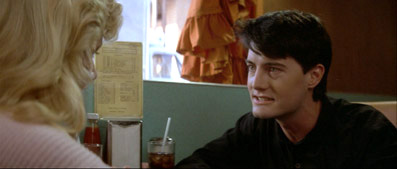
It's only when Jeffrey invades Dorothy's apartment that
a real tonal shift takes place, and it does so with a jolt. From the moment Frank
Booth enters the story, the calm surface serenity is permanently
tarnished. The film no longer peeks into the underworld, it swims in it. From here
on in, viewing events as we do almost solely from Jeffrey's
viewpoint, every moment is tinged with danger. Even Jeffrey's
developing relationship with Sandy puts him on unsafe ground,
as she is keen that her existing boyfriend – the school
jock – should not suspect anything, but we all know he will
and that there will be consequences to face.
Jeffrey's
curiosity proves insatiable, and his encounter with Dorothy
Valens – who on discovering him hiding in her apartment first threatens
him with a knife, then forces him to strip and seduces him –
awakens in him a thirst for the unusual even he did not
realise he possessed. "I don't know whether you are a detective
or a pervert," the unknowing Sandy says at one point –
"That's for me to know and you to find out," he
replies with a mischievous smile. In truth, even he is probably
not sure where one ends and the other begins – like Brad
in The Rocky Horror Show, Jeffrey has tasted blood
and wants more. But nothing in his experience has prepared him
for Frank. Emerging from Dorothy's apartment one
night, Jeffrey is confronted by Frank and his gang, who take him and Dorothy for a 'ride' he will never forget. Until now
Jeffrey has merely been flirting with danger – from this point
on the threat is immediate, sinister and unwavering.
Part
of the film's extraordinary hold
comes from its richly developed and layered characters.
In only his second major film role (his first was in Dune,
also directed by Lynch), Kyle MacLachlan makes Jeffrey a
sympathetic and immensely likable figure – even when he is two-timing
Sandy with Dorothy he seems to embody that part of us that is attracted to a risk that we would usually dare not take.
Jeffrey himself reflects the film's fascination with duality,
his relationship with Sandy offering stability and normality,
while his one with Dorothy is more of a dark fantasy, something
highly desirable that is nevertheless fraught with risk
and could ultimately prove destructive to all involved. It is no secret
that Jeffrey is thought to represent Lynch himself, from
his love of mysteries to his singular dress sense (the buttoned-up
shirt with no tie became a Lynch trademark), which puts
an uncomfortable spin on the abusive aspect of
his relationship with Dorothy. But whatever the reasoning,
it's disarmingly easy to empathise with Jeffrey, and when things go
badly for him, it can be genuinely frightening.
Of
course, a key reason for this, as anyone who has seen the
film will tell you, is Dennis Hopper's astonishing performance as Frank Booth. A larger-than-life but somehow
still terrifyingly realistic figure, Frank is a violent, sadistic
control freak who is permanently bombed out of a variety
of drugs, which have effectively disabled any sense of morality
he may ever have had. Frank is walking handgun with a twitchy hair
trigger that just about anything can set off. On my first viewing, the moment when the frustrated and angry Jeffrey
hits Frank full in the face, I was completely convinced
that our hero was going to be dead within the next few minutes.
What made it worse was that I felt every bit as powerless
and frustrated as Jeffrey and thus shared his terror
at what this spontaneous act was going to provoke.
But what follows, like so many scenes in the film, takes
you completely by surprise – Frank does indeed beat Jeffrey
within an inch of his life, but before doing so kisses him
repeatedly with lipstick-covered lips and gives him a ferocious
fatherly lecture on the dire consequences of being a "good neighbour"
to Dorothy.
It is here that we are most acutely aware that in some
ways Frank is the dark side of
Jeffrey, something evident in the younger man's increasingly abusive relationship with Dorothy. Frank recognises
this, and before the punch that provokes the eventual beating he stares wildly at Jeffrey and hisses enthusiastically, "You're like
me!"
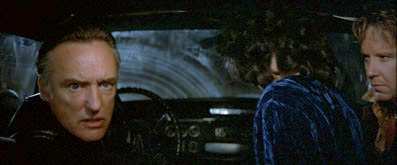
Frank
remains to this day one of the greatest of all screen monsters,
in part because he seems to embody all of the worst traits
of every real-life bastard you have ever encountered, and
then some. Like the two other most frightening film villains
in recent years – the debt collector in Ken Loach's Raining
Stones and Ben Kingsley's Don Logan in Sexy
Beast – Frank's most intimidating weapon is his use
of language and the constant threat of the violence that hovers
behind it. Hopper's role in this is crucial. Having
someone say "Shut the fuck up!" is one thing,
but when Hopper does so it is often through angrily gritted teeth
and a face contorted with rage, something he is able to
snap into in a microsecond. Frank employs language as a control
technique, the flip side of Jeffrey's hesitant uncertainty
with words in moments of crisis. This is at its most pronounced
when Frank catches Jeffrey emerging from Dorothy's apartment,
an encounter that leads to the fateful road trip. Jeffrey
knows all too well the danger Frank represents, and after
an initial verbal encounter, Frank adopts a tone of false friendliness that catches
the nervous Jeffrey off-guard:
Frank: |
Hey,
you want to go for a ride? |
Jeffrey: |
No
thanks. |
Frank: |
No
thanks? What does that mean? |
Jeffrey: |
I...I
don't want to go. |
Frank: |
Go
where? |
Jeffrey: |
For
a ride. |
Frank: |
A
ride! Now that's a good idea! |
Like
the unfortunate Cowboy when suddenly reeled on by Sgt. Hartman in the opening scene of Full Metal Jacket, Jeffrey is doomed from the moment he
opens his mouth – whatever he says, Frank will twist the
conversation against him, and if he can't do it with words then
he will use his fists, a knife or a gun. Frank always gets
his way, and God help any poor bastard who tries to stop him doing so. In one of the most memorable exchanges, Frank
asks Jeffrey what type of beer he likes.
"Heineken," replies Jeffrey unknowingly, sending
Frank into an instant rage. "Heineken!?" he bellows,
"Fuck that shit! Pabst Blue Ribbon!" I have often
wondered what would have happened if Jeffrey had made the
right choice here, though I can't help thinking that Frank would still
have found a way to turn it around and beat him with
it.
The
story of Hopper's reaction to getting the role is now legend,
but still worth repeating for the uninitiated. The actor apparently phoned
Lynch at home when he was entertaining
friends and told him over-enthusiastically that he had to
play the role because "I am Frank!" Lynch
returned to his gathering and told them that Dennis Hopper
had just called and told him he was Frank, which was great
for the movie, "but how are we going to have lunch
with him?" It should be noted that another actor up
for the role and desperate to get it was Robert Loggia,
who threw a fit at Lynch after being kept waiting for
several hours without explanation. Lynch clearly remembered
this and put it to use later when he cast him as Mr. Eddie
in Lost Highway.
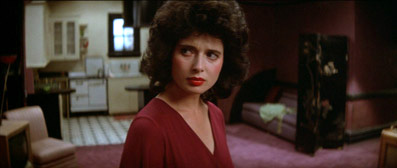
The men may seem to be calling the shots here, but in quality of performance, the women
match them all the way. In her
feature film debut, Laura Dern is just right as Sandy, pretty in an appropriately girl-next-door
way and nicely balancing innocence
with youthful curiosity. She really immerses herself in the
role when required – when confronted with the truth of Jeffrey's
involvement with Dorothy, her face contorts into a
huge, silent scream of dismayed disbelief. As Dorothy, Isabella
Rosselini gives an extraordinary and brave performance,
being really run through the emotional and physical mill
in a role that has her unflatteringly naked, bruised, repeatedly
hit, sexually assaulted and verbally attacked, and which sees her convincingly sell the notion that she derives sexual pleasure from physical abuse.
It is Rosselini's role that takes the film into its most
uncomfortable territory – what begins as a study of voyeurism,
of a child hiding in his parents' wardrobe and seeing more
than he bargained for, develops into a deeply disturbing
examination of the link between violence and sex that reaches
no comfortable conclusions.
Lynch
has repeatedly been attacked, usually from people who want
their stories told in a straightforward manner,
for being weird for weird's sake, but Blue Velvet is a testament to the power of surrealism as a narrative tool.
The first stop on Jeffrey's Road Trip with Frank is a fine example, when the flamboyant Ben, wonderfully played by Dean Stockwell,
mimes to Roy Orbison's In Dreams using a vehicle inspection
lamp as a microphone. A sequence notable for its
haunting strangeness, it's also loaded with character and narrative information:
about Frank's friendship with Ben (he clearly holds him
in far higher regard than anyone else, while the look
of genuine worry on Ben's face when Frank's almost orgasmic
enjoyment of the song dissolves into borderline fury suggests
that Ben knows only too well what Frank is capable of, and
just when to back off); about Dorothy's declining relationship
with her kidnapped child (allowed to briefly visit him,
her initial excitement gives way to cries of concern – "No,
no, mummy loves you!" – and utter dejection as she slowly
shuffles out to join the impromptu audience); about Frank's
involvement in a violent drug robbery; and about the shallow
nature of Frank's oddball gang (which includes Brad Dourif
and Lynch favourite Jack Nance), hangers-on who, under Frank's
umbrella of anger, get to act tough and live dangerously
but who themselves are terrified of upsetting their leader. "Do you want me to pour it?" Dourif's Raymond asks as he apprehensively
holds the beer Frank has been angrily calling for, only
to have Frank bark back "No, I want you to fuck it!" The singular use of lighting, camera placement, ambient
sound and music help create a very real sense of a waking
nightmare, enlarging the sense of danger and heightening
the appallingly fragile nature of Jeffrey's predicament.
Astonishingly,
in the midst of this nightmare world, Lynch fashions a
genuinely touching love story, as Jeffrey and Sandy make a most believable transformation from
co-conspirators to boyfriend and girlfriend. In one strangely moving sequence,
Sandy tells Jeffrey of a dream she has had in which thousands
of robins are released to bring love back into the world,
a scene that seems to border on cornball and then bounces
back to reality as the couple stumble over their words ("You're
a neat girl" – "So are you...I mean...").
As they dance at a party at which their relationship is
finally revealed to others, the use of Julie Cruise's haunting The Mysteries of Love charges a scene that could have
so easily been cheapened through the use of too-familiar
pop ballard,** and Lynch only lets the sequence play out as
long as it needs to for us to register the narrative turn
and the emotion of the moment. Such storytelling economy is
on display throughout, resulting in a work that is full
to the brim with story and character detail yet never feels
hurried or uncomfortably busy. It feels so right that what
in most thrillers would be a big action climax – a violent
shoot-out between police and Frank's gang – is handled as
a brief montage to the strains of Ketty Lester singing about
"Love letters straight from your heart." Typical
of the film's layering is that Frank uses the term "love
letter" to describe a bullet from a gun. "You
get a love letter from me," he warns Jeffrey, "you're
fucked forever!"
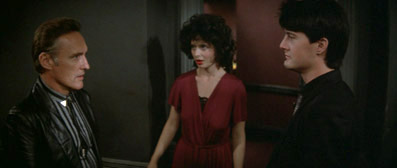
Having
been forced to confront the dark side of his nature, Jeffrey
ultimately tries to bury it, only to have it
return and explode in his face.
The final message may initially seem a somewhat conservative
one, as Jeffrey triumphs over evil and embraces suburban
normality in a fairytale ending that borders on the absurd,
but on repeated viewings this takes on a whole new level
of meaning. Love does conquer all, but at a cost – Jeffrey,
his family and his probable bride-to-be are happy and normality
has been restored, but their world is now a superficial one without any sense of adventure, danger or
risk. Jeffrey and his family are now as emotionally hollow
as the legendary wives of Stepford – Frank may have been
destroyed, but without him Jeffrey is just one more smiling,
undemanding face behind the white picket fence of suburbia.
When he was with Frank or with Dorothy he may have looked
into the abyss, but while he was doing so he was, in every
sense of the word, alive.***
On
a technical level, everything about the film is just right.
Frederick Elmes' cinematography is consistently arresting, beautifully composed and noir-influenced imagery that repeatedly shatters the myth
that the scope frame cannot be used to create intimate
two-shots. Elmes also plays with the concept of how low the light level can be for us to still clearly read a scene, a concept Peter Deming took
close to its limit in Lynch's later Lost Highway.
The sorely missed Alan Splet, who remains one of cinema's most talented ever sound designers and made such an important
contribution to the unique feel of Lynch's Eraserhead and The Elephant Man, does some of his
best work here. From the rumble of crawling insects
to the thunderous flutter of a flame
being blown by wind, or the slowed down animal roar of Frank in full fury
and the buzz of electricity in the surrealistic climax, Splet's sound work is crucial to
the film's palpable sense of menace. This is enhanced by Patricia Norris's
sometimes expressionistic production design, the bright,
clean lines of Jeffrey's home giving way to the dark colours
of Dorothy's apartment block and the strange hues and Lynch's
signature uplighters in Ben's apartment, creating a world that is both real and surreal, evoking a sense of nightmare
without moving the film into the realms of fantasy.
As
a die-hard David Lynch fan it's hard for me to say which
I really consider to be his greatest film. My favourite
will probably always be Eraserhead, on the
basis of its extraordinary originality, its astonishing
imagery and sound and the devastating effect it had on
my when I first saw it back in the late 70s. I adored The
Elephant Man for its spellbinding character detail,
storytelling and emotional wallop, The Straight
Story for the confidence with which it walks the line between
touching character drama and cornball sentimentality, Lost Highway for having the balls to reject all traditional narrative
and character traditions and mess with its audience on a
level somewhere between their subconscious and their very worst
nightmares, and Twin Peaks for, well, just about
everything. But though it may seem like I'm running with the
crowd, I have to admit that Blue Velvet remains the movie where all of these elements most exquisitely
gel. It works perfectly as a character drama, as a nightmarish thriller,
as a complex mystery, as a study of voyeurism, as a peek into the darker side
of the soul, and...hell, so much more. Ultimately, Blue Velvet is that rarest of beasts, a
compelling entertainment that is also an immaculately realised work of
art.
It
may seem a tad superficial to comment on the boxes in
which the two disks come, but it really is worth a mention
here. Both are presented in the standard plastic DVD cases,
but are encased in a cardboard sleeve that distributors
seem to feel is mandatory if their disk is going to be
taken seriously as a special edition. The region 1 has
a nice glossy sleeve, but absolutely full marks must go
to Sanctuary for their region 2 sleeve, which has been
given a mock velvet-like covering that no doubt added
to the production cost, but does create the sense that
someone at Sanctuary really cared about this disk.
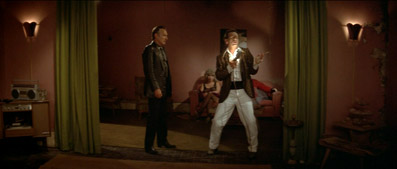
The
menus on both disks are similarly well designed and presented,
using video imagery and audio clips from the film on the
main menu, with animated transitions to sub-menus.
Both
disks present the picture in its original aspect ratio
of 2.35:1 and with anamorphic enhancement. The region
1 disk is the second release from MGM and the picture
quality is, on the whole, very good and a slight improvement
on the first release. Contrast is generally impressive
and colour rendition is excellent. Sharpness is the only
real issue here – some sequences seem just a tad soft,
and it's too long since I last saw the film on a cinema
screen to make direct comparisons. This is still the best
the film has looked on a home video format – previous
tape releases were a complete disaster, especially in
the dark scenes in Dorothy's apartment block, which lacked
any sort of detail and looked as though they had been
filmed through a layer of mud. No such problems here – Frederick Elms' sometimes extreme use of shadow and low
light is reproduced with impressive clarity. The transfer
on the region 2 disk appears to be identical – comparing
the two side-by-side I found no significant differences
in any area.
Previously
released with a stereo soundtrack, both disks sport the
same new 5.1 track, but there are little signs here of a
major remix, hardly surprising considering Lynch's lack
of involvement with either DVD and the loss of sound designer Alan R. Splet.
The 5.1 is certainly fuller than the 2.0 equivalent, and
music and atmospherics are spread nicely around the sound-stage,
but though there is a specific use of stereo in the front
sound stage at times, the rears seem to be on auto-pilot.
There are a fair number of giveaway moments when the sound of a car door
that is closed in front of your eyes can be heard coming from
both the front and rear speakers. Low frequency work is
rather nice in places, but will depend very much on the
configuration of your sound set-up. The track's major plus
is its clarity – the excellent use of sound effects and
music is reproduced very cleanly, though you can't help
wondering what Lynch and Splet might have done with the
wonders DTS at their disposal.
It
is here that the two releases really part company. Just
looking at the boxes you might think that the region 2 disk
has the edge – it's a two disk special edition, while MGM's
region 1 is on a single disk. But get this – the first extra
on the region 1 disk is actually longer than all of the
extras on region 2 disk combined. Another case of a single
disk special edition spread unnecessarily over two DVDs.
US Region
1
The
Mysteries of Love is a 71 minute retrospective
documentary on the genesis and making of the film and is
divided into eight chapters that can be accessed directly from
the menu. This is a wonderfully detailed and thorough extra
that includes interviews with almost all of the key personnel
involved in the making of the film, including Kyle MacLachlan,
Laura Dern, Dennis Hopper, Isabella Rosselini, producer
Fred Caruso, cinematographer Frederick Elmes and Lynch himself.
Lynch is notorious for his lack of cooperation on home movie
versions of his films and presumably had no intention of
being interviewed for this documentary, so his contributions
have been sourced from older interviews from a variety of mysterious
sources – some of them look like amateur footage, and one
is shot in silhouette – but their content is invaluable.
There is a clear narrative structure, following the process
of making and releasing the film from start to finish, told
exclusively through interview and edited in a very economical
and lively fashion – a story started by one interviewee
will be continued sometimes mid-sentence by a second person and
concluded by a third. This works well, and gives both authenticity
to the information and a pace and dynamism to the documentary
itself. Extracts are plentiful, of decent quality and do
not hog interview space. A great deal of fascinating information
is delivered, and there are some intriguing stills, on-set
footage and even what look like home movie extracts of Lynch
at work included. An excellent extra, it is presented 4:3
with a Dolby 2.0 stereo soundtrack.
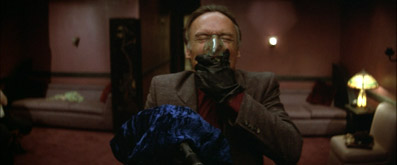
There
is also an Easter Egg here – when
presented with the chapters for the Mysteries of Love documentary, you can highlight the documentary title and
get a 45 second extract from Isabella Rosselini's interview,
not included in the documentary itself, in which she talks
very briefly about the accusations of misogyny made over
the way her character is treated in the film.
The Deleted Scenes Montage is an intriguing
but half-finished inclusion. The biggest surprise it delivers
is in the opening caption, where it reveals that the first
edit of the film was actually four hours long and
cut down to two hours for contractual reasons. Having whetted
your appetite for what you think you are going to get, a
second caption painfully reveals that all of the cut scenes
have now been lost, despite the valiant efforts of film
researchers. What follows is an attempt to recreate the
feel of some of these scenes using numerous publicity stills,
which have been divided into scenes and pieced together
like a slide show and set to Baldalamenti's score. The result
is genuinely illuminating – there were scenes in which Jeffrey
met Sandy's boyfriend socially, for instance, and a potentially
alarming moment in which Frank leaves a second ear from
Dorothy's husband in her bathroom sink, but we are given
only visual information here, and are left wondering much
of the time what the scene was actually about, exactly where
it fitted into the narrative, and how the dialogue played
out. Since drafts of the script were used to assemble these
montage sequences, this information could have been supplied
textually and would have made this extra considerably more
engaging.
Siskel
and Ebert 'At the Movies' 1986 is is a 1 minute
30 second extract from the famous TV review show in which
the two critics argue the merits or otherwise of the movie – Roger Ebert, a critic of considerable intelligence and
perception (but who occasionally pulls a spectacular boner),
appears to have been genuinely offended by it, and rather
miffed at his colleague's positive reaction.
The Photo Gallery has three sections. Lumberton,
USA is a collection of on-set photos which are divided
into six sub-sections, none of which are that busy – the
last, 'It's a Strange World' has only two pictures. International Posters is exactly what it sounds
like – but there are only 4 on show here. Peter Braatz photos has 18 photographs taken on set by this respected
photographer. Some of these are rather nice, but like all
of the images in this extra, and similar extras on so many
other disks, the pictures are presented at about one third
of screen size, so you'll have to shuffle forward to get a
really good look.
Trailer/TV
spots features the original theatrical trailer, which runs for
1 minute 30 seconds and is 16:9 anamorphic, and two TV spots,
which run 30 seconds each and are 4:3. All are in slightly
wobbly shape, but watchable.
UK Region
2
Strange
Desires is a retrospective documentary very much in the style of The Mysteries of Love on the region 1 disk, but
runs for less than half its length at 31 minutes. Many of
the same people are interviewed, but like the earlier documentary
Lynch has played no actual part in the production and his
contributions are taken from other sources (his opening
address to camera, for instance, is taken from a BBC arts
programme shown shortly before the release of the film in
the UK, in which Lynch presented a number of little seen
surrealistic short films). Though the two documentaries
cover much of the same ground, Strange Desires inevitably does so in far less detail, with considerably
fewer interviews and none of the on-set footage that makes Mysteries so intriguing. It is still a decent enough
documentary, and gives a fair level of information on the
making of the film and how it has been read. There are no
interviews with Isabella Rosselini or Kyle MacLachlan, and
some of Hopper's interview is almost word-for-word the same
as the (different) one in the region 1 documentary, but
there are a couple of contributions from Dino DeLaurentis, which Mysteries doesn't have. The biggest contribution
here is from Frederick Elmes, who downplays his own work
to an extraordinary degree, suggesting at one point that
his cinematography may have added very little to the feel
of the film. Is he kidding? In the end, though, Strange Desires feels much less thorough and detailed
than The Mysteries of Love, and though almost half
its length seems to give less than a quarter of its information.
This may well prove the deciding factor for fans on which
disk to buy. The picture is 16:9 anamorphic and the sound
Dolby 2.0.
Moving
Pictures is a segment from the sorely missed BBC movie programme
of the same name in which novelists JG Ballard and Jenny
Diski and film-maker Gavin Millar analyse what makes the
film tick, and why it is such an important work. Though
Millar and Diski are more coldly analytical, Ballard is
a huge fan of the film and speaks very enthusiastically
about it, something revealed in his opening statement: "Without
any doubt it is the best film of the 1980s." Shot on
4:3 video with Dolby 2.0 sound, it includes some very grubby
16:9 extracts from the film, and though running just 12
minutes, the analysis is fascinating and detailed, and it
is a most useful inclusion. It has a special place here
at Outsider, as when the segment was first shown, Moving
Pictures presenter Howard Schumann quoted and agreed
with a cinema-goer who said, "I may be sick, but I
want to see that again." This was, as he has more than
once reminded me, fellow reviewer Camus, who also caught
the film at the Lumiere in London when that was the only
cinema in the UK showing it. ****
Finally
there is the Trailer, which runs
for 1 minute 25 seconds, is framed 16:9 anamorphic with
a mono soundtrack and is in iffy shape – the closing graphics
are so clean and stable by comparison they look as if they
have been redone for this DVD inclusion.
As
with any film, all views are subjective, but as far as I
am concerned Blue Velvet is nothing short
of a cinematic masterpiece. I've seen it many times
now, but it still comes across as fresh and original on
every viewing, and given some of Lynch's more experimental
works before and since, may well represent an ideal introduction
to his oeuvre for the uninitiated.
Previously
released on a very poor region 2 disk, this re-release from
Sanctuary is most welcome, but for those with multi-region
playback capability (which should really include all of
you) the choice is not so straightforward. Both the region
2 and the MGM region 1 special editions have pretty much
the same, generally fine anamorphic transfer and 5.1 soundtrack,
but if you're a fan of the film then MGM's region 1 disk
wins hands down on the basis of its documentary, The
Mysteries of Love, which beats the equivalent on the
region 2 disk on length, detail, interviews and the sheer
volume of information it contains.
|